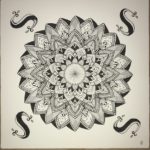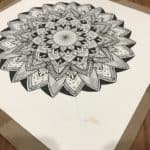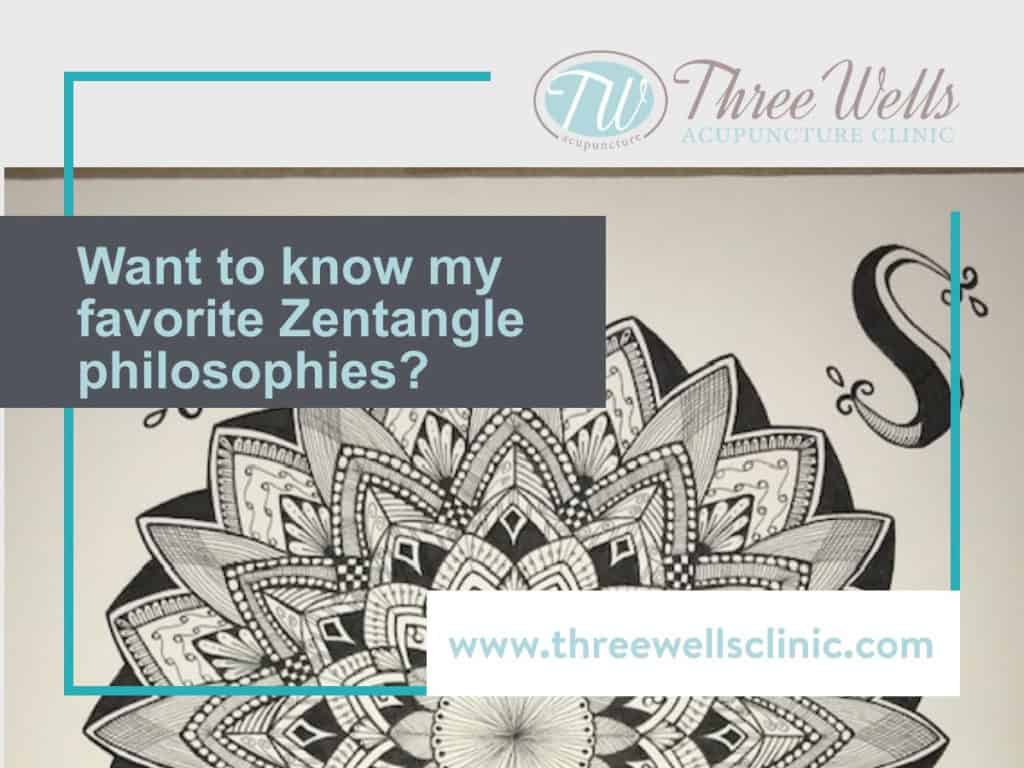One of the side benefits of following the covid-19 shelter-in-place orders was being able to finish a Zentangle project I started about a year ago and put down for awhile.

In all the years I’ve been practicing Zentangle, this Zendala (Zentangle-inspired mandala) is probably my most favorite one I’ve done so far.
But I didn’t know that until I got to the end of it.
Which makes me think of how much this piece contains the philosophy of Zentangle that you can apply to everyday life (yes, even now when life looks different than it did a very short time ago.)
Philosophy #1: One stroke at a time
There is no pre-planning in Zentangle. No expectation of what the final piece is going to look like.
All you focus on is the next line that your pen is going to make. Then the next. Then the next.
When I started this piece, I had NO idea what it was going to become. I used a pencil dot grid to draw in the underlying petals of the mandala but that was the only pre-decision for the whole tile.
 I began with the pattern in the middle circle. Once that was done, I chose what pattern to use for the next round. And once that was done, I decided on the pattern for the next round.
I began with the pattern in the middle circle. Once that was done, I chose what pattern to use for the next round. And once that was done, I decided on the pattern for the next round.
We never know what life is going to look like. We can have all sorts of expectations of what we think it SHOULD look like, but we each probably have a thousand examples of how it turned out different than planned.
It’s okay to not know the outcome of where you’re going in life. Just decide the next step you want to take.
Philosophy #2: No Mistakes, Only Opportunities
In my Zentangle classes, we draw in pen and I don’t give out erasers. I get a lot of panicked looks when I announce to my students there are no mistakes.
Does that mean that we don’t make any mistakes? Buwahahahaha! Of course we make mistakes!
But just like in life, we don’t get to erase our mistakes. We just call it an “opportunity,” (or an oops-ortunity) figuring out how to make peace with what happened and move on.
Early on, I had a big oopsie on this piece. There was a big brown smudge on the paper in an area I wasn’t planning on covering. I’m guessing chocolate.
I don’t know how it happened and I was not happy about it. In fact, I even considered tossing it in the garbage.
“What’s the point? I ruined it. Might as well get rid of it and start another one.”
But then that little voice inside whispered, “Just hang on – it’ll be okay in the end. You’ll figure out what to do.”
And I did.
At first I thought about just covering it up – I could get a circle matting that would hide it if I placed it just right.
Instead, I made it become part of the art by drawing matching S swooshes in each corner, covering up the smudge, and I love how it turned out.
Yes, it is possible that a mistake can lead you to something better. Hang in there with it.
Philosophy #3: It’s okay to ask for help and share ideas
I admit I was stuck on how to make an opportunity out of my mistake. In the picture above, you can see pencil marks where I was trying to sketch around it trying to decide what to do.
I was stuck so I asked my husband for ideas. As an Eagle Scout, the mandala made him think of a compass so he suggested I add an N, E, S, W to make it look like a compass.
Traditional Zentangle is meant to be non-representational – not looking like anything in particular – with no up or down. But that gave me the inspiration for the S swooshes in each corner.
It’s okay to feel stuck sometimes. And it’s okay to ask for help. The decision of what to do next is still yours, but it’s okay to gather ideas to see what inspires you.
Philosophy #4: Start wherever you are
Zentangle is never meant to be a competition.
I guarantee you this:
Someone is going to look at the picture of my Zendala and think “gosh, I could NEVER do that.”
And someone else is going to look at it and think “gosh, I could do WAY better than that.”
Neither opinion matters.
I use Zentangle as my favorite version of stress relief and a way to express myself creatively.
My skill is better than some – I’ve been tangling weekly, if not daily, for years. AND my skill is nowhere near the skill of others.
Again. It. Doesn’t. Matter.
It’s tempting to compare though. Most of my ideas for patterns in this Zendala came from Zareen Taj Hidhayath’s “Mandala Guidebook”.
Zareen is an AMAZING mandala artist (click here to see some of her work). Instead of being intimidated by or jealous of her talent and skill, I allowed her work to be an inspiration for me and that makes all the difference.
Don’t compare your chapter 1 to someone else’s chapter 20. Click here to read more about being new at something.
Start where you are.
Interested in Zentangle?
I am available to teach online Zentangle classes to individuals or small groups. Check out the Zentangle page for more info and contact me if you’d like to schedule a class.
This post may contain affiliate links, meaning I may receive a commission (at no extra cost to you) if you use that link to make a purchase. See my disclaimer.
Is Three Wells right for you?
Get a free 15 minute Q&A consultation to find out!
